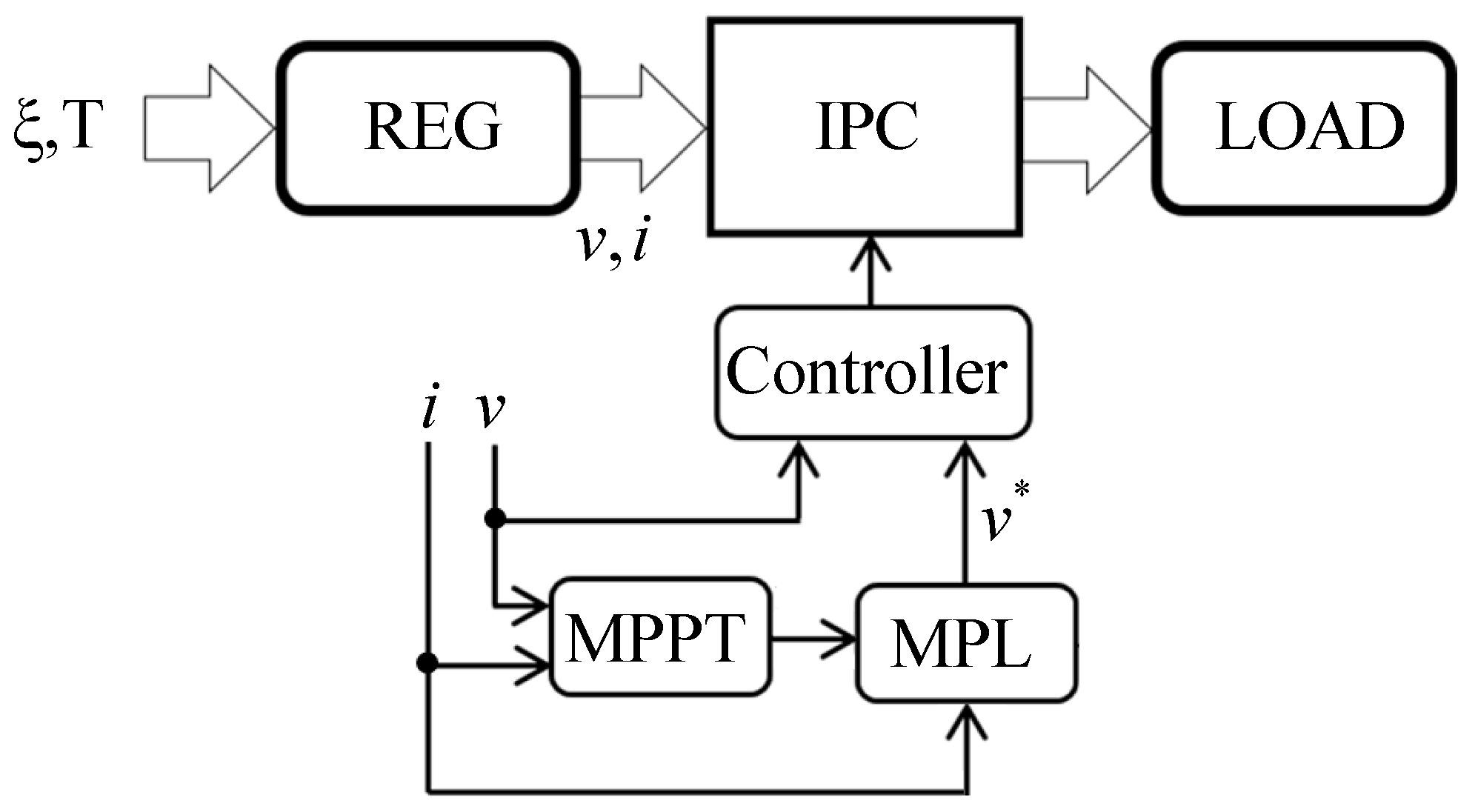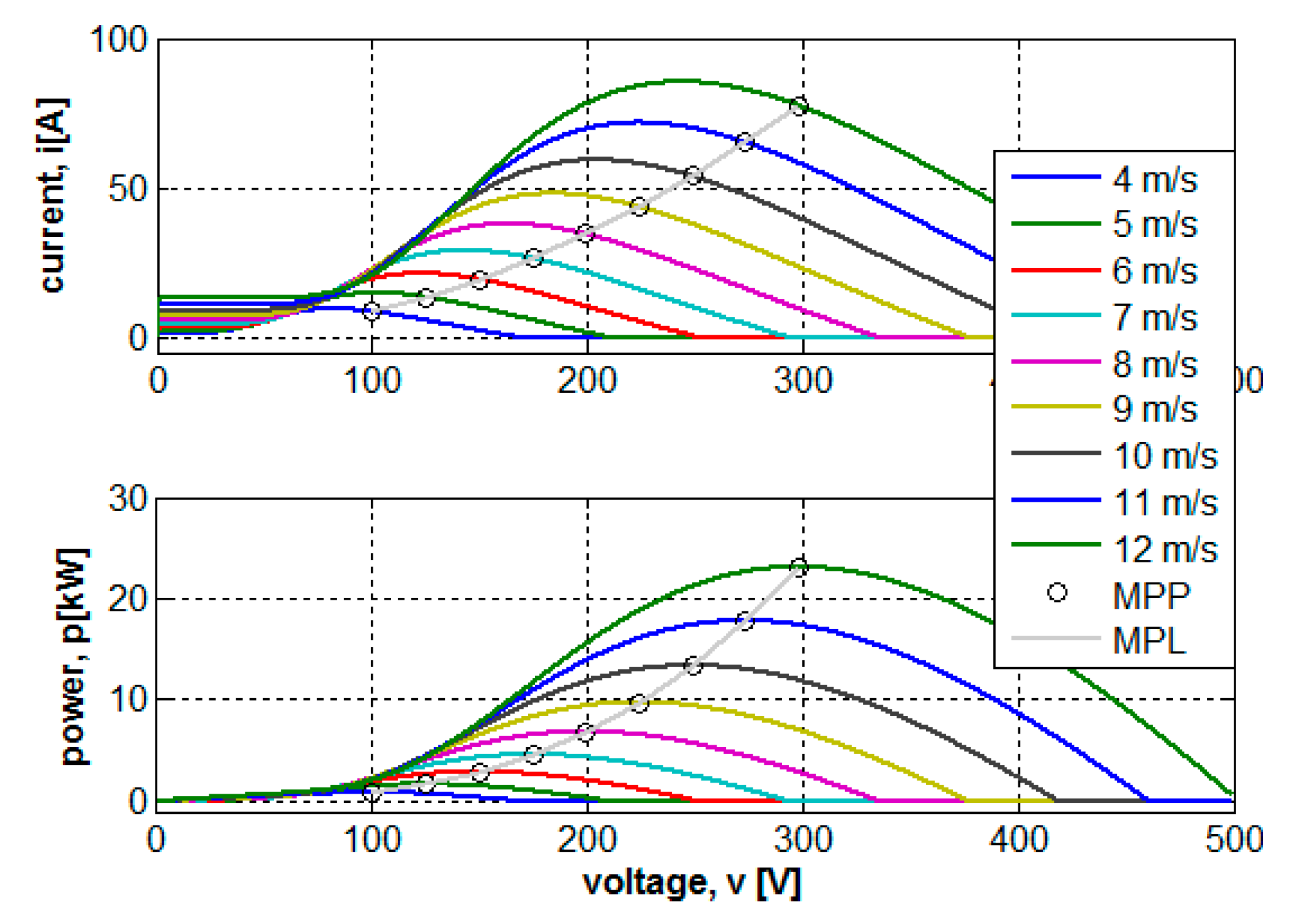Analytical Derivation of Electrical-Side Maximum Power Line for Wind Generators
Abstract
:1. Introduction
2. Wind Turbine Generator (WTG) MPL Derivation
3. Numerical Example
4. Discussion
- Even though a simple model of a DC Generator was utilized, it may be easily shown that in case permanent magnet generator (PMG) driving a three-phase diode rectifier (DR) is utilized, the solution form remains (some scaling should be carried out). Interested readers are referred to [7,11] for detailed modeling of a PMG-DR unit.
- The derived expression (17) contains KMPP and is therefore temperature-dependent. This is the main reason (apart from parameter uncertainty and possible variations) for the necessity of employing MPPT algorithm in addition to utilizing MPL. Nevertheless, since both temperature and parameter variations are relatively slow, high-bandwidth MPPT is unnecessary.
- The MPL for solar generators was recently derived in [12] and is given bywhere χ(∙) is a nonlinear operator (Lambert-W function related) and Rs is solar generator output series resistance. Note that the form of (18) is similar to that of (17), including temperature dependence. This further supports the similarity between solar and wind generators, recently pointed out in [13].
- It should be pointed out that if friction and series resistance are neglected, (17) reduces toindicating pure quadratic relation between DC current and voltage. This result was reported in some earlier works. Furthermore, comparing (19) to the right-hand side of (6) reveals that in case the DCG is lossless (i.e., perceived as an ideal mechanical-to-electrical energy transformer), (19) is a mechanical-to-electrical domain transformation of (6); i.e., v ~ ωT and i ~ TW.
5. Conclusions
Conflicts of Interest
References
- Gadelovits, S.; Kuperman, A.; Sitbon, M.; Aharon, I.; Singer, S. Interfacing renewable energy sources for maximum power transfer—Part 1: Statics. Renew. Sustain. Energy Rev. 2014, 31, 501–508. [Google Scholar] [CrossRef]
- Kolesnik, S.; Sitbon, M.; Gadelovits, S.; Suntio, T.; Kuperman, A. Interfacing renewable energy sources for maximum power transfer—Part II: Dynamics. Renew. Sustain. Energy Rev. 2015, 51, 1771–1783. [Google Scholar] [CrossRef]
- Kumar, D.; Chatterjee, K. A review of conventional and advanced MPPT algorithms for wind energy systems. Renew. Sustain. Energy Rev. 2016, 55, 957–970. [Google Scholar] [CrossRef]
- Kolesnik, S.; Kuperman, A. On the equivalence of major variable-step size MPPT algorithms. IEEE J. Photovolt. 2016, 6, 590–594. [Google Scholar] [CrossRef]
- Sokolov, M.; Shmilovitz, D. A modified MPPT scheme for accelerated convergence. IEEE Trans. Energy Convers. 2008, 23, 1105–1107. [Google Scholar] [CrossRef]
- Scarpa, V.; Buso, S.; Spiazzi, G. Low-complexity MPPT technique exploiting the PV module MPP locus characterization. IEEE Trans. Ind. Electron. 2009, 56, 1531–1538. [Google Scholar] [CrossRef]
- Xia, Y.; Ahmed, K.; Williams, B. Wind turbine power coefficient analysis of a new maximum power point tracking technique. IEEE Trans. Ind. Electron. 2013, 60, 1122–1132. [Google Scholar] [CrossRef]
- Tan, K.; Islam, S. Optimum control strategies in energy conversion of PMSG wind turbine system without mechanical sensors. IEEE Trans. Energy Convers. 2004, 19, 392–399. [Google Scholar] [CrossRef]
- Duong, M.Q.; Grimaccia, F.; Leva, S.; Musetta, M.; Le, K.H. Improving transient stability in a grid-connected squirrel-cage induction generator wind turbine system using a fuzzy logic controller. Energies 2015, 8, 6328–6349. [Google Scholar] [CrossRef] [Green Version]
- Heier, S.; Waddington, R. Grid Integration of Wind Energy Conversion Systems; Wiley: Chichester, UK, 2006. [Google Scholar]
- Dalala, Z.; Zahid, Z.; Lai, J. New overall control strategy for small scale WECS in MPPT and stall regions with mode transfer control. IEEE Trans. Energy Convers. 2013, 28, 1082–1092. [Google Scholar] [CrossRef]
- Kolesnik, S.; Sitbon, M.; Lineykin, S.; Batzelis, E.; Papathanassiou, S.; Suntio, T.; Kuperman, A. Solar irradiation independent expression for photovoltaic generator maximum power line. IEEE J. Photovolt. 2017, 7, 1416–1420. [Google Scholar] [CrossRef]
- Kolesnik, S.; Kuperman, A. On the similarity between low-frequency equivalent circuits of photovoltaic and wind generators. IEEE Trans. Energy Convers. 2015, 30, 407–409. [Google Scholar] [CrossRef]




© 2017 by the authors. Licensee MDPI, Basel, Switzerland. This article is an open access article distributed under the terms and conditions of the Creative Commons Attribution (CC BY) license (http://creativecommons.org/licenses/by/4.0/).
Share and Cite
Kolesnik, S.; Kuperman, A. Analytical Derivation of Electrical-Side Maximum Power Line for Wind Generators. Energies 2017, 10, 1498. https://doi.org/10.3390/en10101498
Kolesnik S, Kuperman A. Analytical Derivation of Electrical-Side Maximum Power Line for Wind Generators. Energies. 2017; 10(10):1498. https://doi.org/10.3390/en10101498
Chicago/Turabian StyleKolesnik, Sergei, and Alon Kuperman. 2017. "Analytical Derivation of Electrical-Side Maximum Power Line for Wind Generators" Energies 10, no. 10: 1498. https://doi.org/10.3390/en10101498
APA StyleKolesnik, S., & Kuperman, A. (2017). Analytical Derivation of Electrical-Side Maximum Power Line for Wind Generators. Energies, 10(10), 1498. https://doi.org/10.3390/en10101498





